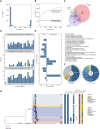Emergence and global spread of Listeria monocytogenes main clinical clonal complex
- PMID: 34851675
- PMCID: PMC8635441
- DOI: 10.1126/sciadv.abj9805
Emergence and global spread of Listeria monocytogenes main clinical clonal complex
Abstract
The bacterial foodborne pathogen Listeria monocytogenes clonal complex 1 (Lm-CC1) is the most prevalent clonal group associated with human listeriosis and is strongly associated with cattle and dairy products. Here, we analyze 2021 isolates collected from 40 countries, covering Lm-CC1 first isolation to present days, to define its evolutionary history and population dynamics. We show that Lm-CC1 spread worldwide from North America following the Industrial Revolution through two waves of expansion, coinciding with the transatlantic livestock trade in the second half of the 19th century and the rapid growth of cattle farming and food industrialization in the 20th century. In sharp contrast to its global spread over the past century, transmission chains are now mostly local, with limited inter- and intra-country spread. This study provides an unprecedented insight into L. monocytogenes phylogeography and population dynamics and highlights the importance of genome analyses for a better control of pathogen transmission.
Figures





Similar articles
-
Whole-Genome Sequencing Analysis of Listeria monocytogenes from Rural, Urban, and Farm Environments in Norway: Genetic Diversity, Persistence, and Relation to Clinical and Food Isolates.Appl Environ Microbiol. 2022 Mar 22;88(6):e0213621. doi: 10.1128/aem.02136-21. Epub 2022 Feb 2. Appl Environ Microbiol. 2022. PMID: 35108102 Free PMC article.
-
Listeria monocytogenes Source Distribution Analysis Indicates Regional Heterogeneity and Ecological Niche Preference among Serotype 4b Clones.mBio. 2018 Apr 17;9(2):e00396-18. doi: 10.1128/mBio.00396-18. mBio. 2018. PMID: 29666282 Free PMC article.
-
Listeria spp. Isolated from Tonsils of Wild Deer and Boars: Genomic Characterization.Appl Environ Microbiol. 2021 Feb 26;87(6):e02651-20. doi: 10.1128/AEM.02651-20. Print 2021 Feb 26. Appl Environ Microbiol. 2021. PMID: 33397708 Free PMC article.
-
ADSA Foundation Scholar Award--An integrated science-based approach to dairy food safety: Listeria monocytogenes as a model system.J Dairy Sci. 2003 Jun;86(6):1865-75. doi: 10.3168/jds.s0022-0302(03)73774-6. J Dairy Sci. 2003. PMID: 12836921 Review.
-
Lessons from an outbreak of listeriosis related to vacuum-packed gravad and cold-smoked fish.Int J Food Microbiol. 2000 Dec 20;62(3):173-5. doi: 10.1016/s0168-1605(00)00332-9. Int J Food Microbiol. 2000. PMID: 11156259 Review.
Cited by
-
Listeria monocytogenes ST37 Distribution in the Moscow Region and Properties of Clinical and Foodborne Isolates.Life (Basel). 2023 Nov 5;13(11):2167. doi: 10.3390/life13112167. Life (Basel). 2023. PMID: 38004307 Free PMC article.
-
High density genomic surveillance and risk profiling of clinical Listeria monocytogenes subtypes in Germany.Genome Med. 2024 Oct 7;16(1):115. doi: 10.1186/s13073-024-01389-2. Genome Med. 2024. PMID: 39375806 Free PMC article.
-
Foodborne bacterial pathogens: genome-based approaches for enduring and emerging threats in a complex and changing world.Nat Rev Microbiol. 2024 Sep;22(9):543-555. doi: 10.1038/s41579-024-01051-z. Epub 2024 May 24. Nat Rev Microbiol. 2024. PMID: 38789668 Review.
-
Evaluation of the Persistence and Characterization of Listeria monocytogenes in Foodservice Operations.Foods. 2022 Mar 20;11(6):886. doi: 10.3390/foods11060886. Foods. 2022. PMID: 35327308 Free PMC article.
-
Comparative Genomics of Listeria monocytogenes Isolates from Ruminant Listeriosis Cases in the Midwest United States.Microbiol Spectr. 2022 Dec 21;10(6):e0157922. doi: 10.1128/spectrum.01579-22. Epub 2022 Oct 31. Microbiol Spectr. 2022. PMID: 36314928 Free PMC article.
References
-
- Swaminathan B., Gerner-Smidt P., The epidemiology of human listeriosis. Microbes Infect. 9, 1236–1243 (2007). - PubMed
-
- Charlier C., Perrodeau É., Leclercq A., Cazenave B., Pilmis B., Henry B., Lopes A., Maury M. M., Moura A., Goffinet F., Dieye H. B., Thouvenot P., Ungeheuer M.-N. N., Tourdjman M., Goulet V., de Valk H., Lortholary O., Ravaud P., Lecuit M.; MONALISA Study Group , Clinical features and prognostic factors of listeriosis: The MONALISA national prospective cohort study. Lancet Infect. Dis. 17, 510–519 (2017). - PubMed
-
- Orsi R. H., den Bakker H. C., Wiedmann M., Listeria monocytogenes lineages: Genomics, evolution, ecology, and phenotypic characteristics. Int. J. Med. Microbiol. 301, 79–96 (2011). - PubMed
LinkOut - more resources
Full Text Sources
Miscellaneous

